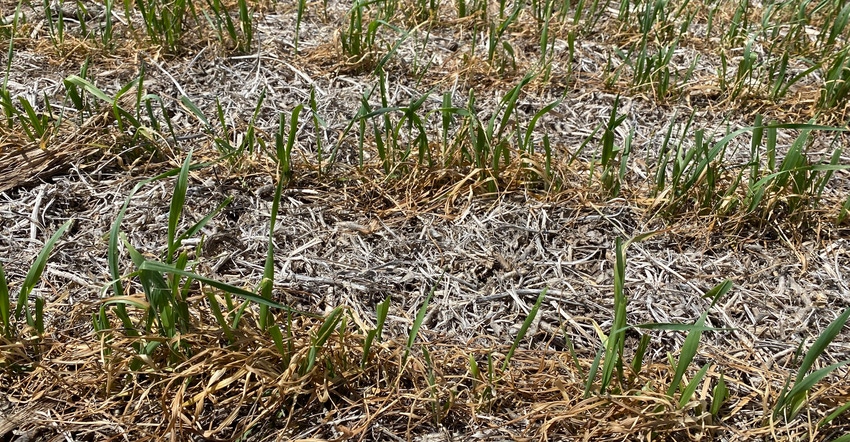May 7, 2020

Just how big a hit the Kansas wheat crop took from freezes the week of April 12 may not be fully known until harvest, but a look at several fields and a weather analysis done by Planalytics Inc. found fields with almost no damage and others with up to 70% of the main tiller heads killed.
In a webinar produced by Planalytics and supported by the University of Kansas, a panel of agronomists and weather specialists addressed agronomic damage to the crop from the successive nights of below-freezing temperatures and the additional damage that has come from the widening area of dry conditions spreading across the state.
Planalytics has a long history with KU’s Kansas Biological Survey, working with the Kansas Applied Remote Sensing program, which specializes in crop yield forecasting and satellite vegetation monitoring.
KARS uses satellite data to produce a weekly map series called the GreenReport, which illustrates current and relative vegetation conditions and trends for the conterminous U.S. The level of “greenness” measured by satellites gives a picture of the health of the crops, said Jude Kastens, research associate professor at KU. Kastens oversees the KARS program.
Southwest Kansas, particularly, has seen a very dry spring, and the U.S. Drought Monitor map of April 29 shows almost 40% of the state in abnormally dry conditions with about 7% in the southwest corner slipping into moderate drought.
Drought is also having an impact in eastern Colorado, the Oklahoma panhandle and Texas.
Kansas has been hit the hardest with freeze damage, with much of the state showing some level of freeze damage. The April freeze was made worse by a warm winter that caused the wheat to break dormancy early and mature rapidly before the cold spell hit in April, according to Jeffrey Doran, senior agribusiness meteorologist with Planalytics.
For the southern half of the state, the wheat was well ahead of jointing with three successive nights of temperatures that dropped in the 20s for three or more hours. In some areas, the wheat already had flag leaves emerged and was entering the boot stage, a time when it is very vulnerable to excessive cold.
The northwest part of the state fared somewhat better because the wheat was not as mature. Wheat that has not jointed is less vulnerable to be killed by the cold, though it can suffer serious leaf damage that requires it to regrow from secondary tillers to make grain.
Looking ahead
What happens next depends on the weather as the month of May progresses, and the forecast is not good according to Michael Greve, director of weather with Planalytics. The first two weeks of May shows a forecast for warmer than normal temperatures and lower than normal precipitation — the exact opposite of what the crop needs to regrow tillers and recover from the damage.
Greve showed a satellite map of wheat country showing the level of “greenness” a measure of how well the wheat crop is growing. The Pacific Northwest was emerald green. Kansas was closer to yellow than green over much of the state — a reflection of both drought and freeze.
John Hecht, an agronomist with Crop Quest Consulting in Wichita, said the south-central area is in better shape than the southwest, but is facing yet another enemy — strip rust, which has been spotted in Oklahoma and has made an appearance in Sumner and Sedgwick counties.
“We’re going to see a lot of fungicide going on as growers fight to keep what they have,” he said.
Greve said the end of May long-term forecast shows a slightly cooler trend but lower precipitation, conditions that are likely to make it more difficult for the crop to recover from the damage of the winter and early spring. He said the cooler trend continues into June.
“We just have to hope for a few timely rains, especially when the wheat reaches that boot to heading stage and starts to need water to make grain,” Greve said. “Fields that get timely rain will get some help. Fields that don’t. Well that’s where we’ll see some losses.”
You May Also Like




